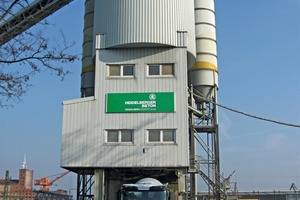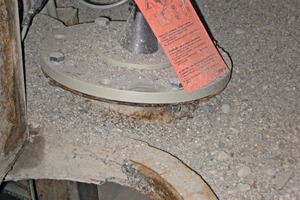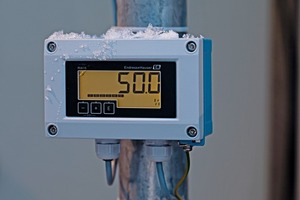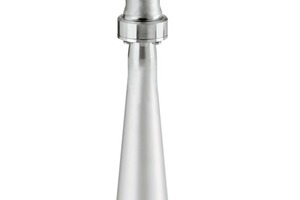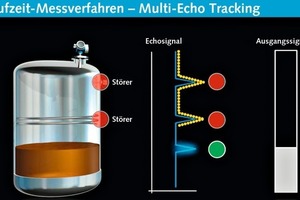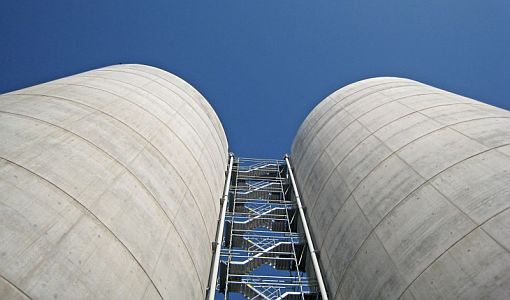Tough test passed with flying colours
1 Introduction
In the bulk material handling sector, the measuring technology is always a challenge, even where mineral bulk materials are concerned. Robust systems are needed, because the products can be coarse-grained and abrasive, or fine-grained and very dusty. There are various different measuring system approaches to the problem of obtaining plausible measurement results in this rough environment.
2 Contact-free and reliable
For the plant owner, safe and plausible measured data are the indispensable basis for effective working of his automation system. The Micropilot FMR 56/57 with its Multi-Echo Tracking was therefore equipped with new and innovative evaluation algorithms that assess every echo signal and trace the course of the echo. All echo signals are first marked in accordance with their short and long-term history. These include the filling level echoes and the interference echoes caused by internal fittings or double echoes. Subsequently, these echoes are traced and subjected to a plausibility analysis. Thanks to the new evaluation process and the self-teaching algorithms, the filling level signal is acquired even if it is under the interference-suppression level. This assures safe and precise measurement at all times, even under severe signal-reflection conditions inside the silo.
Seven different versions of the freely radiating radar Micropilot from Endress + Hauser are available, two of them being intended for use in the bulk materials sector. The Micropilot FMR 56 is the attractively-priced basic model, while the Micropilot FMR 57 is intended for the very highest requirements associated with powdery to lumpy bulk materials.
3 Putting the antenna into the silo compartment
The different additive components are stored in the seven compartments of the multi-compartment silo. The particle sizes of the additive materials range from practically 0 mm up to 16 mm. The individual compartments have a height of 7.8 m and are filled up to a level of approximately 6.6 m. Due to the silo design, the compartments are conical and some sections of the walls have strengthening ribs. These conditions present a major challenge to the determination of plausible measurement data.
For this application, the Micropilot FMR 56 radar sensors were each equipped with a DN 100 horn antenna enabling stronger focussing – the radiation angle is only 8 degrees. This made it possible to use the previous installation position of the old measuring system by merely adding an intermediate flange.
In some of the compartments, the installation location was directly alongside the filling equipment. In this installation situation, the new measuring method has the advantage that it is insensitive to the noise of material falling into an empty silo.
The analog signals of each compartment‘s maximum filling level are converted into the status signal of the maximum limit by a microcontroller-controlled RMA 42 process transmitter. This signal is used for the prevention of overfilling. The system provides the plant operator with filling level data for each individual compartment by means of RIA 15 process indicators incorporated into the 4–20 mA current loop. The process indicators require no auxiliary power, as they are directly supplied from the current loop.
Thanks to the Multi-Echo-Tracking of the new, freely radiating radar system, it was possible to clearly distinguish between multiple reflections and the current filling level signal. This system technology provides the owner of the concrete works with reliable measurements – even under the tough application environment in silos with difficult geometric conditions.
4 Reliable measurement data
thanks to Multi-Echo Tracking
As so often in the bulk materials processing industry, it is only possible to fulfill the demands for an optimal installation location if considerable structural adaptations are carried out. The previously used measuring systems had different general operating conditions, so that use of the existing supports for the new measuring system imposed additional demands on the signal evaluation – in addition to those resulting from the special properties of the stored bulk material. In freely radiating measuring systems, the reflected signals are evaluated by the sensor. However, the sensor receives a whole bundle of signals, including interference signals, cross-echoes caused by reflections, multiple reflections from the silo compartment walls, and others. These unwanted signals are suppressed via the system software. Depending on the application, this can demand a good deal of expert skill during system commissioning.
In the cement silo, the freely radiating radar Micropilot FMR 57 was equipped with an alignment device. This holding device enabled the FMR 57 to be inclined out of the vertical, in order to obtain better reception. During the system commissioning, only a few parameters have to be entered for the basic calibration, such as silo type and filling/emptying slowly or fast. The software does all the rest, calculating the optimum evaluation algorithms.

